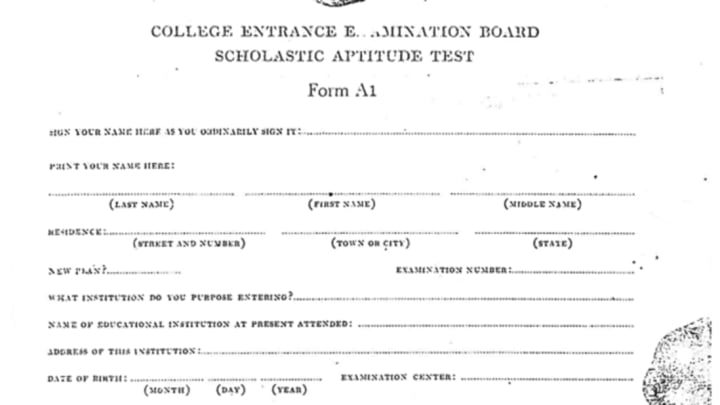Today the College Board announced major changes to the SAT, including a return to the 1600-point scoring system and the elimination of the penalty for guessing. The new test will debut in 2016.
But let's go all the way back to the beginning. The very first Scholastic Aptitude Test was administered to 8,000 students on June 23, 1926. Students had 97 minutes to answers 315 questions on nine subtests, including Definitions, Arithmetic, Logic, Artificial Language, and Paragraph Reading.
The test included questions like “[Blank] is the science of life or living organisms; the study of living matter” and “If a package containing twenty cigarettes costs fifteen cents, how many cigarettes can be bought for ninety cents?” Here are a few more sample questions, via Smithsonian:
"Find the answers to the problem below as quickly as you can. Do all your figuring on the margin of the page."

"Indicate which three [words] are thus MOST CLOSELY RELATED..."

And then there was the Artificial Language section:

The test replaced the College Entrance Examination, created in 1901 by a group of colleges that made up the College Entrance Examination Board (now just the College Board). “[The SAT] was really an attempt by this same group of colleges, which had then expanded somewhat, to get together and say, look, the current test we've got, the essay test with the Latin and the Greek, works fine for prep school students. But we'd like to have more than just prep school students show up on our campus," College Board veteran Brian O’Reilly told Smithsonian last year. And so the SAT—which could determine if both public and private school kids were ready for college—was born.
According to O’Reilly, students weren’t actually expected to finish the test—to do that, they would have had to answer three questions a minute. Students were encouraged to guess: There were no points taken off for wrong answers. That changed in the 1950s, though the guessing penalty is being walked back in this latest overhaul, which will have a major impact on how students are taught to take the test.
You can head on over to Smithsonian for more sample questions from the 1926 version of the exam. To learn more about the new 2016 incarnation, The Wire has a good recap.
